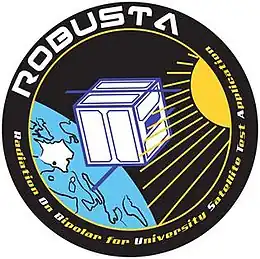ROBUSTA
ROBUSTA (Radiation on Bipolar for University Satellite Test Application) is a nano-satellite scientific experiment developed by the University of Montpellier students as part of a Centre National d'Études Spatiales (CNES) call for student projects in the field of orbital systems.[3]
 | |
| Mission type | Technology |
|---|---|
| Operator | Centre Spatial Universitaire Montpellier-Nîmes |
| COSPAR ID | 2012-006H |
| SATCAT no. | 38084 |
| Mission duration | 2 years (failed) |
| Spacecraft properties | |
| Spacecraft type | 1U CubeSat |
| Launch mass | 1 kilogram (2.2 lb) |
| Start of mission | |
| Launch date | 13 February 2012, 10:00:00 UTC[1] |
| Rocket | Vega |
| Launch site | Kourou ELV |
| Contractor | Arianespace |
| Orbital parameters | |
| Reference system | Geocentric |
| Regime | Low Earth |
| Perigee altitude | 302 kilometres (188 mi) |
| Apogee altitude | 1,089 kilometres (677 mi) |
| Inclination | 69.47 degrees |
| Period | 98.54 minutes |
| Epoch | 31 October 2013, 04:52:30 UTC[2] |
The satellite is a Cubesat, the name given to a series of nano-satellites developed as part of student projects. The ROBUSTA mission is to check the deterioration of electronic components, based on bipolar transistors, when exposed to in-flight space radiation. The results of the experiment will be used to validate a new radiation test method proposed by the laboratory.[4]
Implementation of the project
The duration of the ROBUSTA project is 6 years, beginning in 2006. The satellite was launched on February 13, 2012 on the Vega rocket's maiden flight,[5] and reentered in the atmosphere in February 2015. An anomaly within the battery recharge system resulted in the loss of the satellite after a few days.[6]
Staff
Teams from several sites, coordinated by the Centre Spatial Universitaire Montpellier-Nîmes worked together.[7] These teams are spread over several sites:
- The mechanical design was done by the IUT GMP of Nîmes;
- Energy management was conducted by IUT GEII of Nîmes;
- The ground segment and communication cards are supported by the IUP PGII Montpellier.
- The controller card was done by Polytech Montpellier and IUT GEII Montpellier.
- The payload is managed by the EEA department of the University of Montpellier.
References
- McDowell, Jonathan. "Launch Log". Jonathan's Space Page. Retrieved 31 October 2013.
- Peat, Chris (31 October 2013). "ROBUSTA - Orbit". Heavens Above. Retrieved 31 October 2013.
- CNES official page for the project https://robusta.cnes.fr/en/ROBUSTA/index.htm Archived 2017-06-17 at the Wayback Machine
- Boch, Jérôme; Gonzalez Velo, Yago; Saigne, Frédéric; Roche, Nicolas J.-H.; Schrimpf, Ronald D.; Vaille, Jean-Roch; Dusseau, Laurent; Chatry, Christian; Lorfevre, Eric; Ecoffet, Robert; Touboul, Antoine D. (2009). "The Use of a Dose-Rate Switching Technique to Characterize Bipolar Devices". IEEE Transactions on Nuclear Science. 56 (6): 3347–3353. Bibcode:2009ITNS...56.3347B. doi:10.1109/TNS.2009.2033686. S2CID 20001729.
- "Robusta-1A". Archived from the original on 2015-07-10. Retrieved 2015-07-09.
- On the (now defunct) ROBUSTA website : https://web.archive.org/web/20130814173904/http://www.ies.univ-montp2.fr/robusta/satellite/
- "Fondation-va.fr".